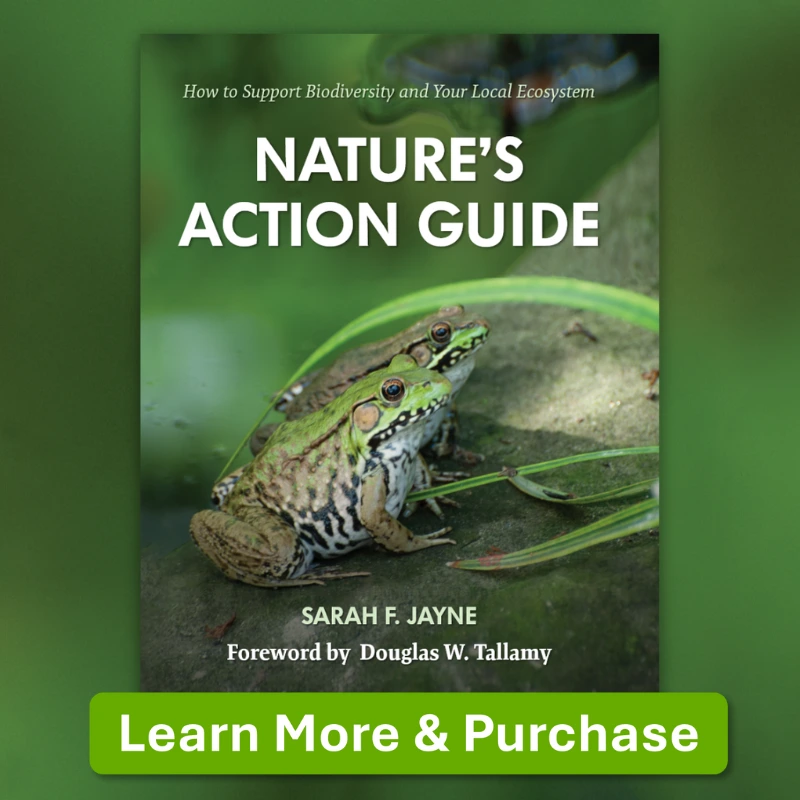Make a Home for Wildlife
Nesting Sites and Soft Landings
JUMP TO A TOPIC: Inviting Caterpillars | Inviting Native Bees | Inviting Birds
GET STARTED GUIDES: Get Started | Shrink Your Lawn | Remove Invasive Plants | Make a Home for Wildlife | Design a Native Landscape
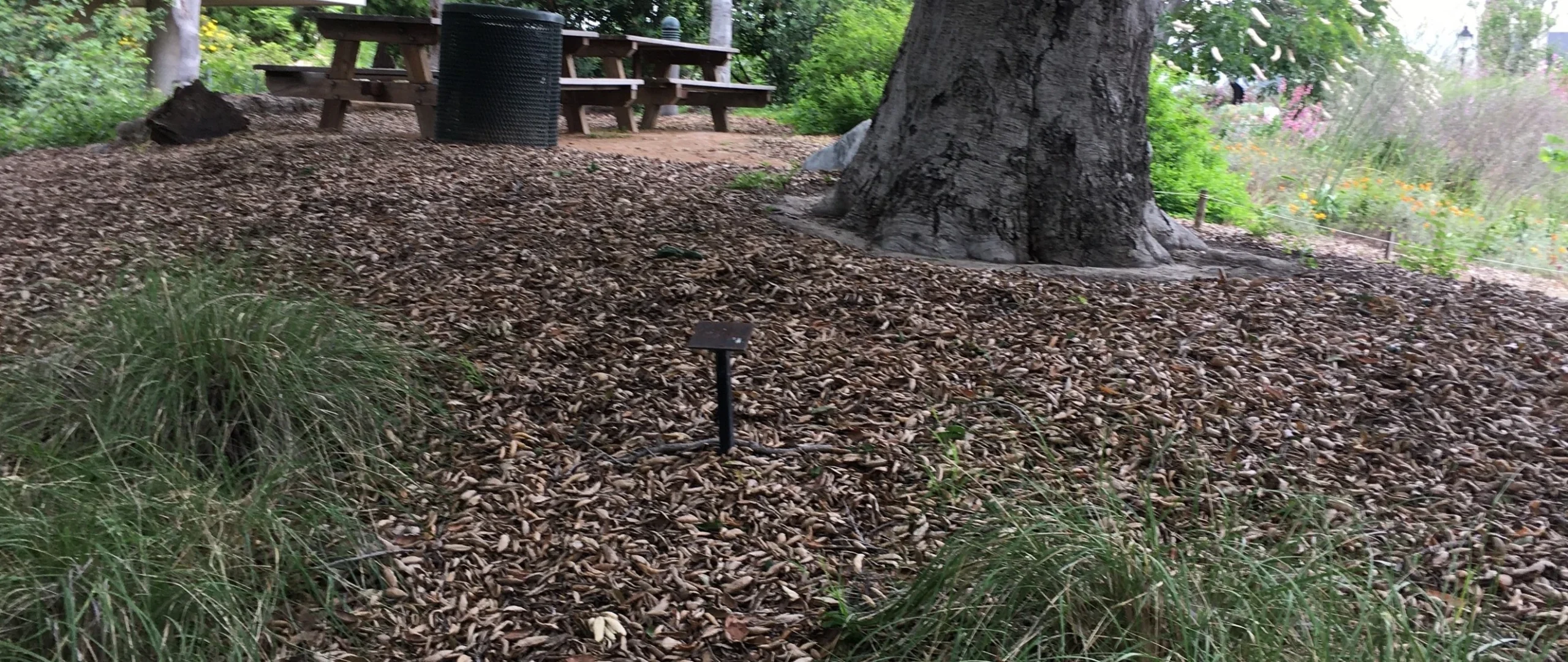
Leaf litter under this California oak offers caterpillars soft landings when they drop down from the tree to pupate.
Planting native plants, especially keystone species, invites insects and other wildlife to our landscapes. As these plants become established in our landscapes, we can see the truth in the saying, “Plant them and they will come!" But how can we encourage our new visitors to remain and become thriving residents in our wildlife habitats? It's actually rather simple: Provide wildlife with food, water, shelter, and places to reproduce.
In this article, we focus on places to reproduce including how to preserve and create pupation sites for caterpillars, wasps, beetles, and other insects and how to encourage nesting sites for bees, birds, and other creatures throughout your landscape.
Pupation sites, also called soft landings*, are planted areas under trees where caterpillars drop to the ground and pupate along with other beneficial insects. The true measure of a rich, supportive wildlife habitat is the presence of pupating and nesting creatures!
*(Soft landings concept developed by Heather Holm and Neighborhood Greening in consultation with Desiree Narango, PhD)
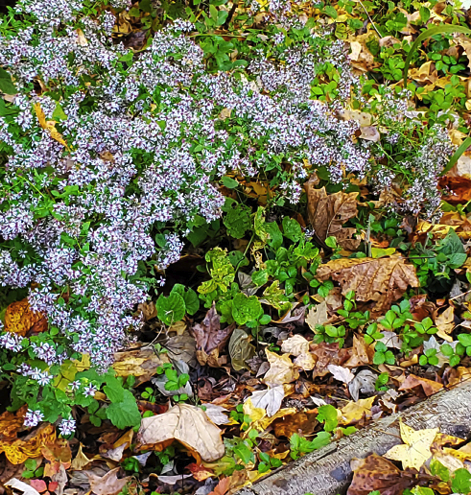
Native plants, leaf litter, and logs create a welcoming habitat for pupating insects and micro life.

The area under this tulip poplar (Liriodendron tulipifera) is not mowed, allowing for soft landings.
Inviting Caterpillars
Create Caterpillar Pupation Sites Under the Trees and Shrubs on Your Property
When a fully grown caterpillar drops to the ground, it will either spin a cocoon in the leaf litter under the tree, or it will burrow into the soil to pupate underground. The soil must be loose and protected from disturbance until the pupa emerges as an adult. Landscape beds can serve as pupation sites; in contrast, the soil under a tree located in the middle of a mowed lawn is compacted and inhospitable to caterpillars. Luckily, it’s not difficult to create pupation sites under trees and shrubs. If you have an existing tree or shrub, remove any lawn to at least the tree's drip line (an imaginary line around the farthest reaches of the leaf canopy). Shown below are the steps for using the Block It! method to create a caterpillar pupation site around a tree growing in the middle of the lawn.

The drip line of a tree (red line).
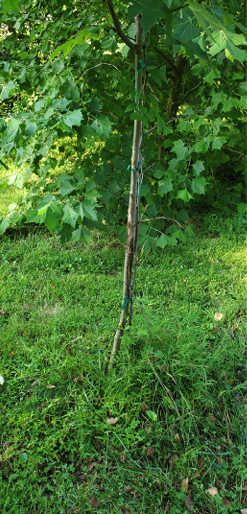
Step 1: Identify the tree (or shrub) under which you want to create a pupation site.
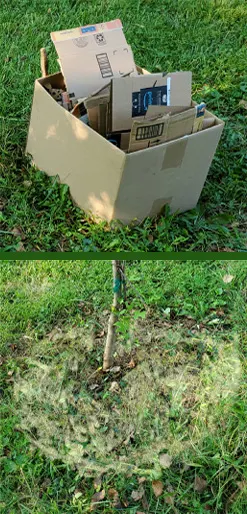
Step 2: Lay out the shape of the pupation site. Be sure it extends at least to the drip line of the tree. Gather leaves and trimmings for mulch.
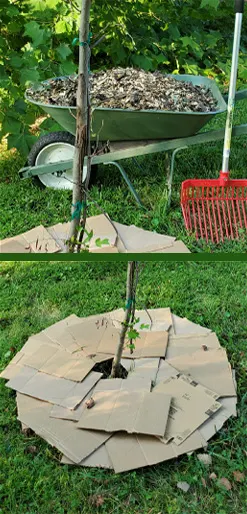
Step 3: Cover the area with cardboard and enough mulch to hold down the cardboard.
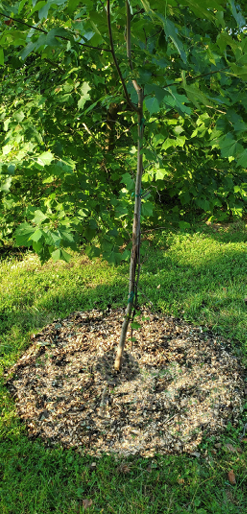
Step 4: Keep the area mulched with a 2-inch layer of leaf litter, trimmings, or other organic matter to help the soil remain friable and to block out persistent weeds.
Step 5: As soon as resources permit, densely plant the area with keystone plants and plants needed by specialists. While waiting for plantings to get established, fill in any gaps with leaf litter or regionally appropriate mulch. Any cardboard that remains will break down over time and mix in with the mulch.
Protect and Support Caterpillar Pupation Sites Throughout the Year
Once you've set up a pupation site, take these important actions to support caterpillars throughout their pupation:
 Grow native plants and maintain a layer of leaf litter on all your pupation sites to provide critically needed shelter for pupating caterpillars.
Grow native plants and maintain a layer of leaf litter on all your pupation sites to provide critically needed shelter for pupating caterpillars.
 Add and arrange some rocks and logs or branches in a pleasing design. Include piles of rocks and stacks of logs wherever possible.
Add and arrange some rocks and logs or branches in a pleasing design. Include piles of rocks and stacks of logs wherever possible.
 Avoid disturbing the leaf litter and plants growing in pupation sites.
Avoid disturbing the leaf litter and plants growing in pupation sites.
 Avoid walking on pupation sites. Borders help prevent people from accidentally trampling on pupation sites.
Avoid walking on pupation sites. Borders help prevent people from accidentally trampling on pupation sites.
 Don’t mow pupation sites. Mowing not only crushes pupae, but it also compacts the soil making it impossible for caterpillars to burrow into the soil.
Don’t mow pupation sites. Mowing not only crushes pupae, but it also compacts the soil making it impossible for caterpillars to burrow into the soil.

Increase the size of the caterpillar pupation site as a tree grows and the leaf canopy expands so that there is always a welcoming bed of duff extending to at least the drip line of the tree. Here, this oak has outgrown the current protected pupation site (red line). The caterpillar pupation site needs to be extended out to the tree's current drip line (green line).
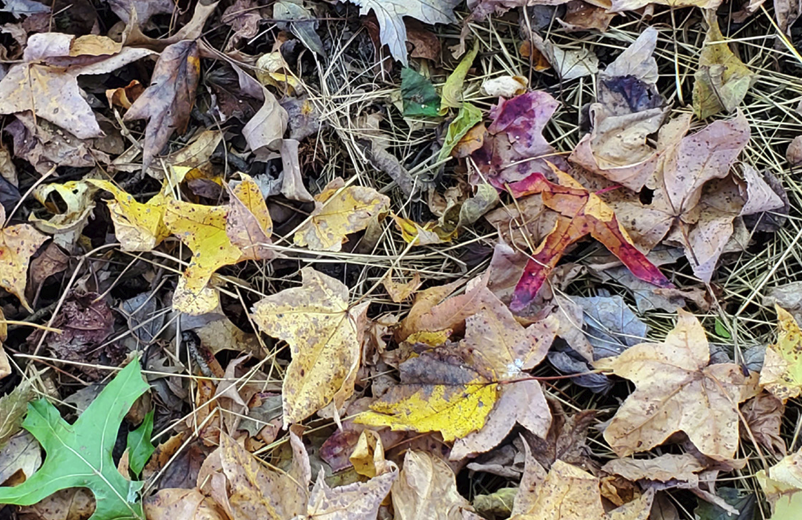
When the leaves drop from your trees, wherever possible, leave the leaf litter. Leaf litter is nutrient-rich "gold" in a wildlife habitat. Some caterpillar species feed on fallen leaves. As leaves decompose, they form a rich layer of duff (decaying organic matter) that provides an ideal habitat for pupating caterpillars, overwintering native bee larvae, and many other small creatures. A layer of duff keeps the soil moist and loose for caterpillars that pupate below the soil surface and bees that excavate underground nests.
Wherever possible, leave a tree's own fallen leaves in place extending all the way out to the tree's drip line to a depth of about 2 inches. Avoid raking the leaves into a pile around the base of a tree trunk!
Caution: To prevent smothering of plants, clear leaf litter away from low-growing ground covers such as mosses, sedges (Carex), pussytoes (Antennaria), and moss pink (Phlox subulata) and away from plants with basal rosettes such as cardinal flower (Lobelia cardinalis).
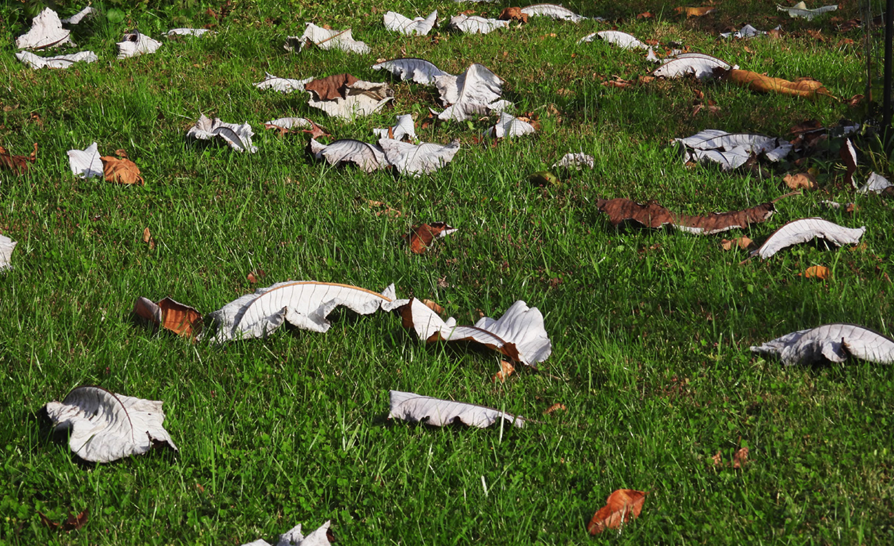
Leaf litter is aptly named—great big leaves from a native magnolia tree really do look like litter on the lawn, but what welcome litter it is!
Leave Stumps and Dead Trees (When Safe) and Place Wood Stacks, Brush Piles, Logs, and Large Rocks All Around Your Property
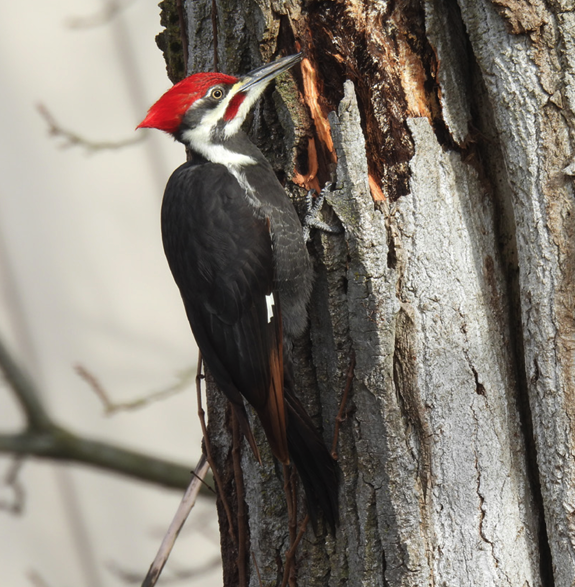
Wherever possible and when it's safe to do so, leave dead branches and snags (dead trees) standing and leave fallen trees and stumps in place on the ground. Many insects and other organisms that play a critical role in the food web feed and reproduce on deadwood. For example, the pileated woodpecker shown here depends primarily upon carpenter ants and other wood-boring insects who inhabit deadwood. Deadwood also offers reproduction sites for species of cavity-nesting birds and some species of native bees and other creatures. The very survival of these animals depends on the availability of rotting wood, deadwood, or existing cavities!
With a mature height measuring 16 to 19 inches, the pileated woodpecker (Dryocopus pileatus) is the largest woodpecker in North America. Deadwood provides the insects and shelter this woodpecker needs to survive.
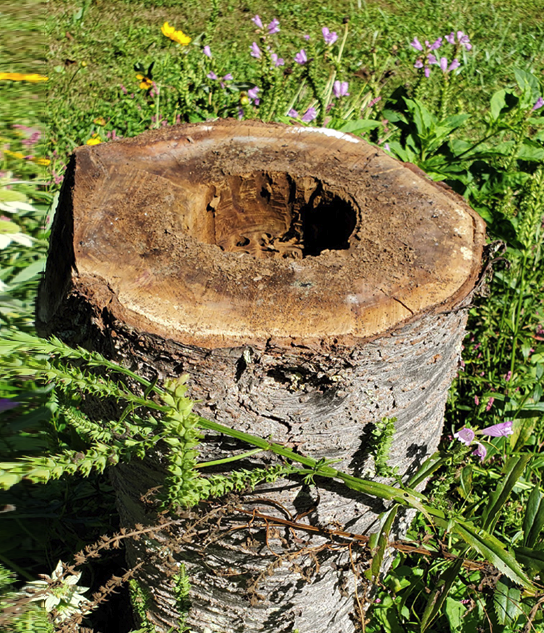
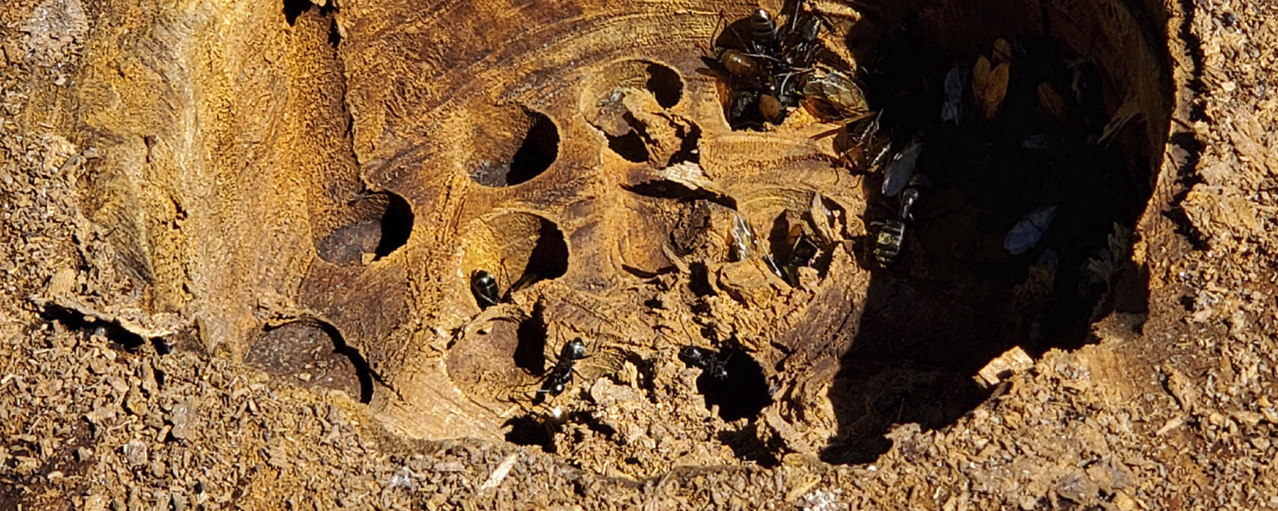
We had a dead tree in the front yard, so we could not leave it for deadwood. Right after we cut the tree down and placed a birdbath on the stump (shown at left temporarily uncovered), carpenter ants (above) occupied it and have been there ever since.
There is nothing like a wood stack or pile of branches to provide shelter for insects, small birds, and other creatures along with habitat for fungi and micro life in the soil. Place the pile somewhere hidden from view at least ten feet away from any buildings. Consider planting a screen around the pile to hide it from view.
Inviting Native Bees
Supply Safe Nesting Places for Native Bees: Deadwood, Bare Ground, and Pithy and Hollow Plant Stems
Ensuring that native bees in your wildlife habitat have safe nesting places, though not difficult, requires some planning. Unfortunately, mismanaged artificial bee nests can lead to predation and disease in native bee populations. By providing deadwood, bare ground, and pithy or hollow plant stems, artificial bee nests are unnecessary (and Mother Nature does the housekeeping for you!)
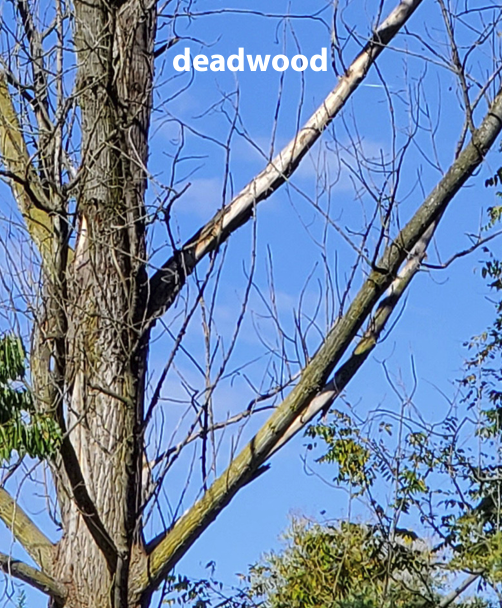
Provide deadwood, brush piles, and stones as habitat for cavity-nesting bees. As we just discussed, deadwood is a critical resource for cavity-nesting native bees, some bumble bee species, and many other animals.
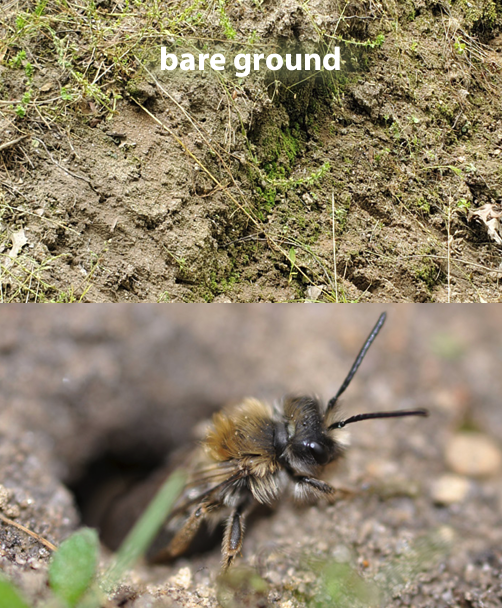
Supply well-situated bare ground for ground-nesting native bees. Sparse vegetation is fine as long as bees have access to bare soil. We'll discuss the needs of ground-nesting bees next.
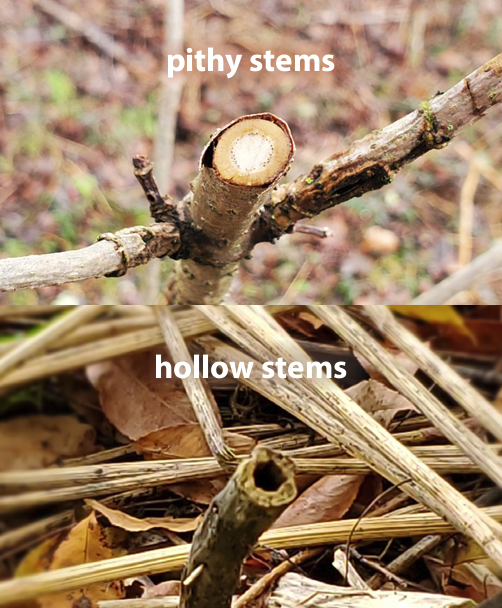
Grow plants with pithy and hollow stems for stem-nesting bees and leave the stems standing. Shortly, we'll explain how to manage stems to benefit native bees with examples of plants that produce ideal stems.
Supply Well-Situated Bare Ground for Ground-Nesting Native Bees
Approximately 70% of native bees are ground-nesters that excavate burrows underground. To support these bees, find an out-of-the-way place on your property where they can nest undisturbed. Ideally, the area should be well-drained with sparse vegetation and sandy or loamy soil that is friable (you could scoop it with a spoon—if you had to for some reason!), although some native bees readily nest in compacted soil. Patches of thin layers of small pebbles or a few small rocks create attractive crevices. A gently sloped site is especially attractive to some bee species. Keep an eye out for small mounds of soil and bee activity.
Unlike ground-nesting yellow jackets, which are a species of wasp, ground-nesting native bees don't sting unless they are seriously provoked at their nesting site. Mostly it is male native bees that hover around the nest, and they don't even have stingers. Discovering native bees nesting in your wildlife habitat is cause for celebration!
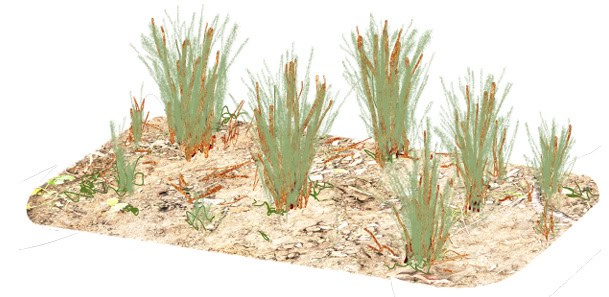
A patch of native grass clumps with ample bare ground between them is an acceptable look for most neighborhoods.
Manage Pithy and Hollow Plant Stems to Optimize Safe Nesting Places for Native Bees
When the urge hits to clean up the garden in the fall and spring, resist the temptation to clear out the garden debris. Instead, help ensure the survival of native bees by leaving the stems and canes of perennial plants to provide nesting sites for native bees. Here's how to do this:
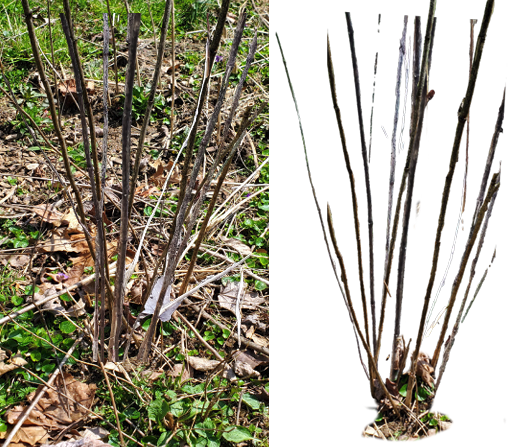
YEAR 1—Fall and winter: Leave as many stems and flower stalks as the aesthetics of your neighborhood will allow. Shown here are stems of Joe-Pye weed (Eutrochium) after a full growing season. Some bee species overwinter in stems.
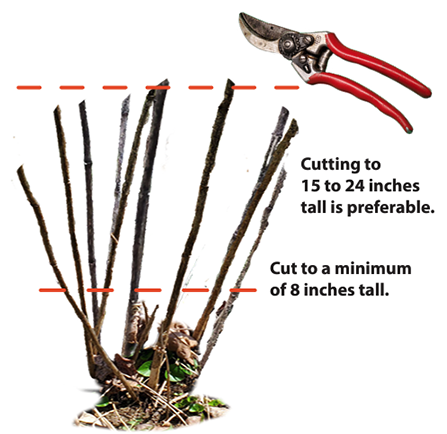
YEAR 2—Spring: Using a sharp tool, cut stems back to varying heights. Leave at least 8 inches of stem. Cutting stems to 15 to 24 inches tall is preferable. Some bee species nest in the spring.
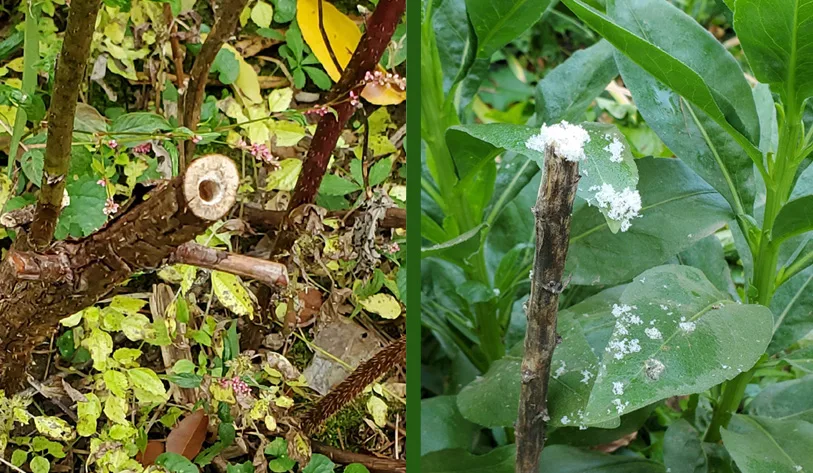
YEAR 2—Summer and beyond: Foliage will begin to cover the cut stems. Be on the lookout for signs of bees excavating the pith from stems (above right). Different bee species will nest and emerge at different times of the year, so be sure to leave the dead stems standing.
YEAR 3: Continue to leave the Year 1 stems (cut in Year 2) standing until they decompose naturally. By now several generations of stem-nesting bee species may have used these stems. Some bee species reuse the stems from previous years. Decomposition of the stems helps to naturally prevent the spread of disease that could come from continual reuse. In spring, cut the stems of Year 2 growth—thus, the cycle begins anew!
Leaving stems is much easier than it sounds!
Simply:
- Wait until spring to cut back stems.
- Cut stems to various heights, ideally between 15 to 24 inches and no shorter than 8 inches.
- Leave the stems in the garden until they decompose (or stack them in a hidden place).
- Repeat annually.
If you live in a neighborhood with rigid aesthetic standards, you may have no choice but to cut stems to 8 inches. This looks tidy and new foliage will quickly cover last year's stems. If possible, take the cut pieces of stem and stack them upright in a hidden area of your property—the bees may still use them.
Grow Native Plants that Produce Pithy or Hollow Stems for Stem-Nesting Bees
Approximately 30% of native bees excavate cavities or use existing cavities in deadwood, stone crevices, or plant stems. Intentionally planting native plants that have pithy or hollow stems will go a long way toward attracting and supporting these native bees. As we just discussed, the other half of the equation is proper management of the stems. Here are examples of plants that provide pithy or hollow stems:
Native Forbs:
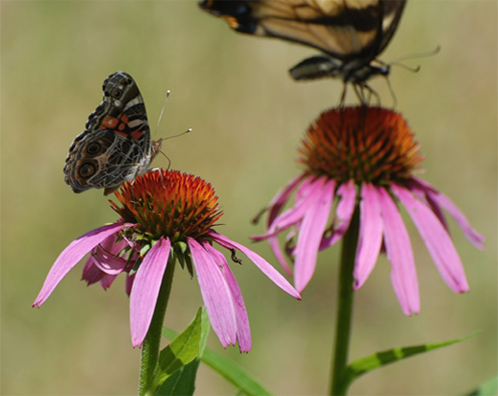
Echinacea species (coneflower)
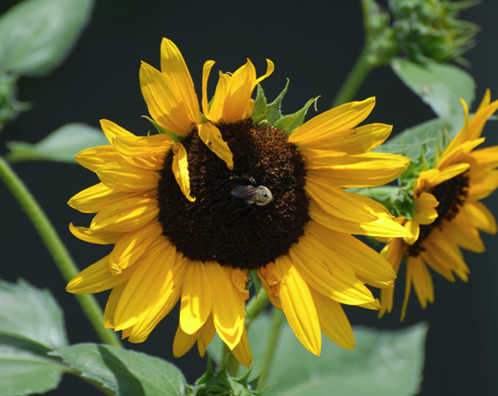
Helianthus species (sunflower)
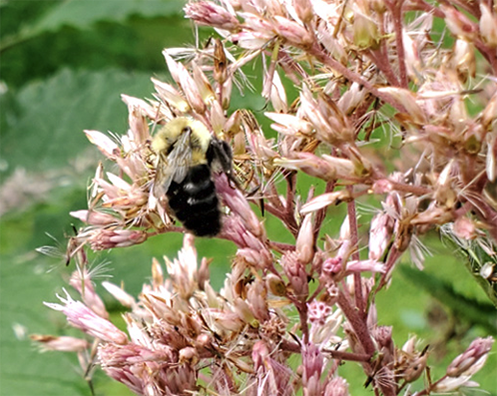
Eutrochium species (Joe-Pye weed)
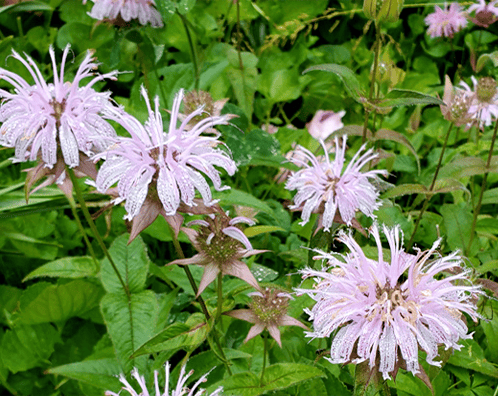
Monarda species (bee balm, wild bergamot)

Silphium species (cup plant, compass plant, rosinweed, prairie dock)
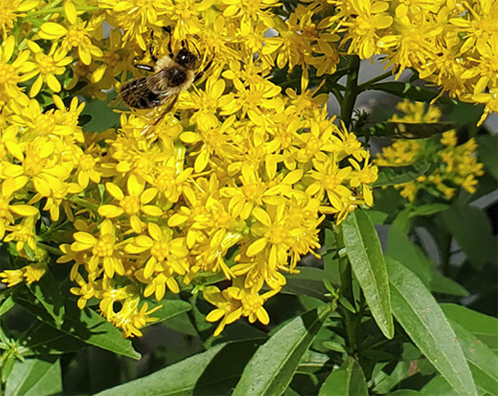
Solidago species (goldenrod)
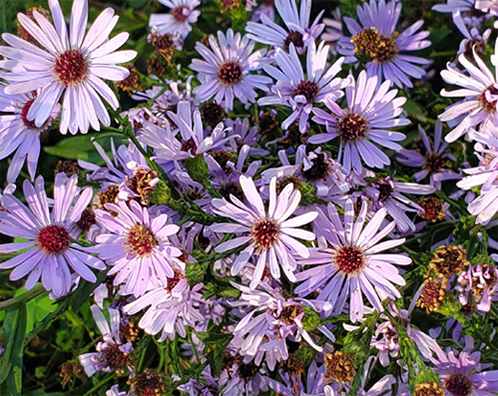
Symphyotrichum species (aster)
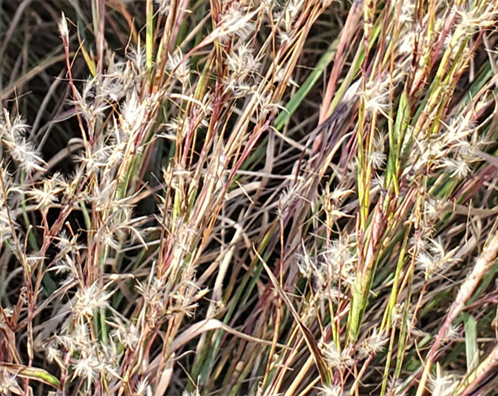
Schizachyrium scoparium (little bluestem), Panicum virgatum (switchgrass)
Native Vines and Shrubs:

Rubus species (blackberry, raspberry, dewberry)
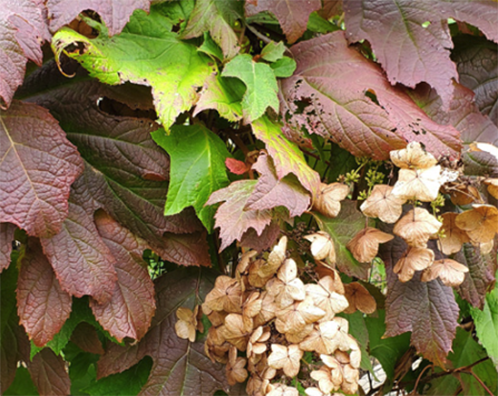
Hydrangea species (oakleaf or smooth hydrangea)
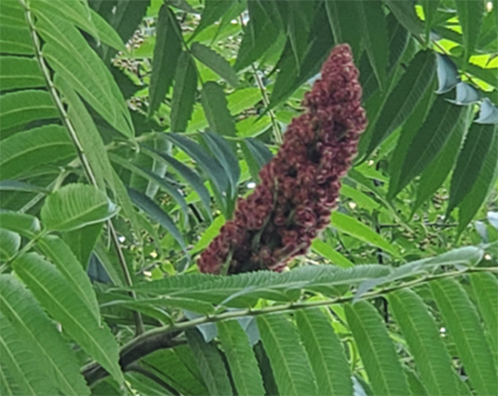
Rhus species (staghorn sumac, lemonade berry)
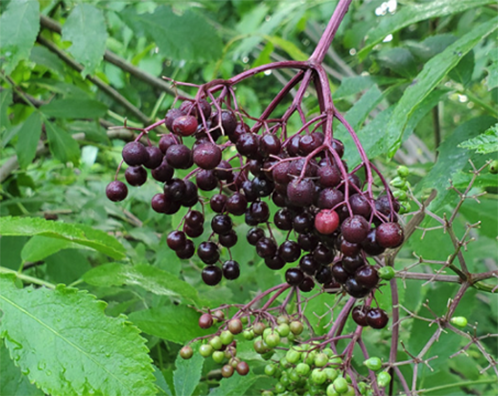
Sambucus species (elderberry)
You will recognize many of these plants as keystone plants. They hold the promise of becoming luxurious multi-unit housing for stem-nesting bees. Next, we'll look at managing and planting your landscape to encourage birds to stay and nest
Inviting Birds
Encourage Birds to Nest In Your Wildlife Landscape
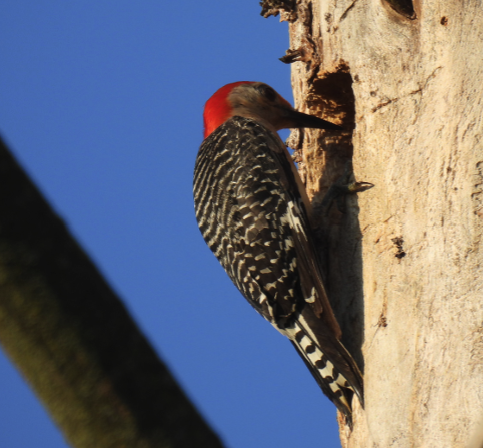
Finding a bird nest in your wildlife habitat is always exciting. Plus, it's a sign that your ecosystem is functioning! Employing bird-friendly ecological management practices, such as leaving deadwood standing and growing native plants, will encourage birds (and the insects they depend on) to live on your property. Cavity-nesting birds often reject human-made cavity nest boxes. If a cavity-nesting bird cannot find a suitable nesting site, it will fail to breed that season.
The shortage of cavity sites is exacerbated by the presence of invasive species of birds, such as the house sparrow (Passer domesticus) and European starling (Sturnus vulgaris), that attack some cavity-nesting bird species further reducing their reproductive success.
This cavity-nesting red-bellied woodpecker (Melanerpes carolinus) relies on soft or deadwood to excavate its nest. Even when it finds deadwood large enough to accommodate its cavity, it must fend off attacks from sparrows and flocks of starlings to protect its eggs and raise its young.
Strategies for Inviting Nesting Birds to Your Wildlife Landscape:
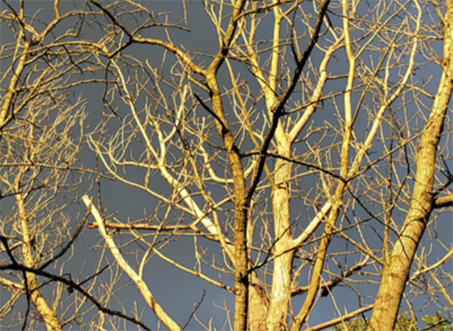
Leave dead trees if they don’t pose a danger. Snags (dead trees) provide ideal nesting opportunities for cavity-nesting birds that mostly reject human-made cavity nests.
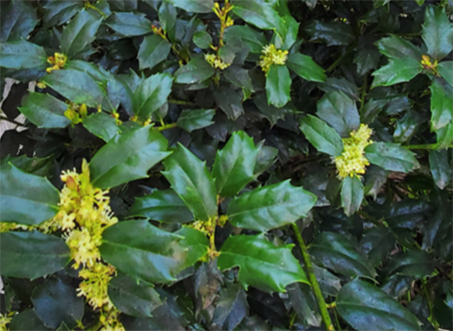
Plant densely branched native trees and shrubs, such as holly or viburnum. A tight network of branches provides protection and a solid foundation for nest-building.

Also, plant open-branched native trees and shrubs which some birds prefer. Hummingbirds and orioles, for example, will nest in sycamore trees.
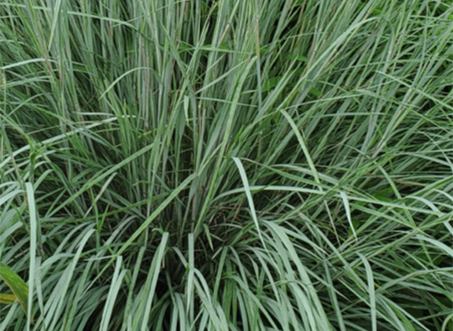
Plant clumping grasses. The clumps provide sheltered places for groundnesting birds to build their nests, and the grass seed provides food.
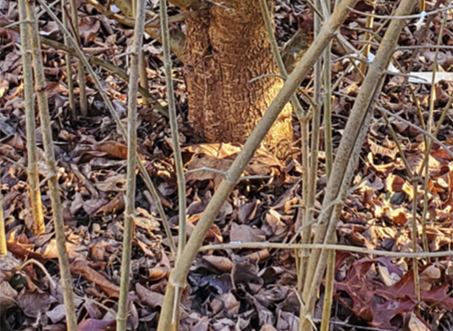
Allow shrubs to sucker (shoots growing at the base of a shrub). These suckers create safe shelter for nesting birds.
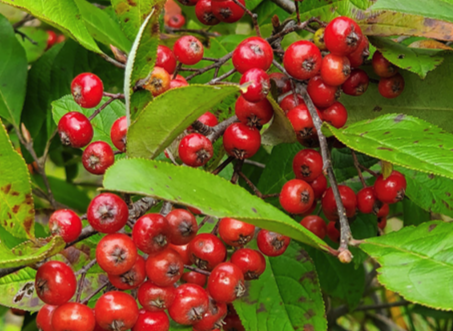
Grow native fruit-bearing shrubs and caterpillar host plants close to nesting sites. These provide a ready supply of food for birds.
This content is an excerpt from Nature's Action Guide by Sarah F. Jayne, shared here with the author’s permission. All rights reserved © 2025 Sarah F. Jayne.
Get the Full Action Guide!
GET STARTED GUIDES: Get Started | Shrink Your Lawn | Remove Invasive Plants | Make a Home for Wildlife | Design a Native Landscape

